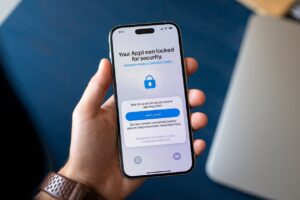Welcome to our comprehensive guide on programming NFC tags for home automation. NFC (Near Field Communication) technology offers a seamless way to enhance your smart home experience by automating tasks with a simple tap. Whether new to NFC or looking to expand your home automation capabilities, this guide will walk you through everything you need to know. Join us as we explore how to program NFC tags and unlock the full potential of intelligent living in your home.
What is NFC Technology?
Near-field communication (NFC) is a wireless communication technology that allows for close-range data transfer between NFC-enabled devices. It operates on radio frequency identification (RFID) principles and enables devices like smartphones and NFC tags to communicate by bringing them close together.
Key Features of NFC:
- Close Proximity: Devices must be within a few centimeters of each other to establish a connection.
- Ease of Use: NFC interactions are initiated simply by bringing two devices close together, making it convenient for everyday tasks.
- Security: NFC transactions are considered secure due to the proximity required for communication.
- Versatility: NFC technology is used for various applications, including contactless payments, ticketing, and, importantly for this guide, home automation.
NFC tags are small passive devices that can store information. They are programmable and can be used to automate tasks around the home with compatible NFC-enabled devices. Understanding these basics sets the stage for exploring how NFC tags can be programmed to enhance your home automation setup.
Benefits of Using NFC Tags for Home Automation
Programming NFC tags for home automation offers several advantages, making it a popular choice among intelligent homeowners.
Convenience
NFC tags provide a seamless way to automate tasks with a simple tap, eliminating the need for manual input or navigating through multiple apps or settings.
Versatility
These tags can be programmed to perform various tasks, such as turning on lights, adjusting thermostat settings, or even playing music, making them versatile tools for enhancing daily routines.
Integration with Existing Devices
NFC technology integrates smoothly with existing smart home devices and platforms, allowing for enhanced control and automation of various household functions.
User-Friendly Setup
Programming NFC tags is relatively straightforward and requires minimal technical expertise. Once set up, users can easily modify or add new automation routines as needed.
Cost-Effectiveness
NFC tags are affordable and readily available, offering a cost-effective solution to enhance the functionality of smart home systems without significant investment.
By leveraging these benefits, homeowners can create a more efficient and personalized home environment using NFC tags for automation.
How to Program NFC Tags for Home Automation
Let’s explore the practical steps in programming NFC tags to automate tasks within your smart home setup.
Step 1: Gather Your Materials
Ensure you have the following:
- NFC-enabled smartphone or tablet
- NFC tags compatible with your devices
- NFC programming app (if required)
Step 2: Install the NFC Programming App (if needed)
Download and install an NFC programming app from your app store. Popular options include NFC Tools for Android and iPhone for iOS devices.
Step 3: Identify Tasks to Automate
Decide which tasks you want to automate using NFC tags, such as controlling lights, adjusting thermostat settings, or setting reminders.
Step 4: Program NFC Tags
Follow these steps to program your NFC tags:
- Open the NFC programming app: Launch the app on your device.
- Select the action: Choose the action you want the NFC tag to perform (e.g., turn on lights).
- Write the task: Hold the NFC tag near your device and follow the app’s instructions to write the action.
- Test the NFC tag: Tap the NFC tag against your device to ensure it performs the desired action.
Step 5: Place NFC Tags Strategically
Position NFC tags in convenient locations around your home, such as near light switches or bedside tables.
Step 6: Customize and Adjust
Experiment with different actions and tag placements to optimize your smart home automation.
Following these steps will help you effectively use NFC tags to enhance automation and convenience in your home.
Examples of NFC Tag Uses in Home Automation
Explore practical examples of how NFC tags can streamline and enhance everyday tasks in your smart home setup:
1. Lighting Control
Program NFC tags near light switches or lamps to turn lights on or off with a simple tap.
2. Media Playback
Place NFC tags near your entertainment system or speakers to play music or videos when tapped.
3. Temperature Adjustment
Use NFC tags to adjust thermostat settings for comfort with a quick tap.
4. Morning Routine Automation
Create an NFC tag near your bedside to automate your morning routine, such as setting alarms or adjusting lighting.
5. Guest Access and Instructions
Place NFC tags near the entrance to give guests instructions or access to your Wi-Fi network.
6. Emergency Information
Program NFC tags with emergency contact information or medical alerts for quick emergency access.
7. Task Reminders
Use NFC tags to set reminders for tasks or appointments by tapping them with your smartphone.
Tips for Effective Use of NFC Tags in Home Automation
Maximize NFC tag benefits with these tips:
- Label and organize tags.
- Test reliability post-programming.
- Place strategically for easy access.
- Group logically for efficient use.
- Secure sensitive data and consider backups.
- Regularly update and expand automation.
- Ensure compatibility for seamless integration.
Conclusion
In summary, NFC tags offer a user-friendly solution for automating tasks like lighting control, temperature adjustments, and reminders in your smart home. With their versatility and ease of use, NFC technology enhances convenience and efficiency, making everyday routines more seamless. Integrating NFC tags into your home automation system allows you to optimize your living space with minimal effort and maximum impact. Explore the possibilities of NFC technology today to transform your home into a more innovative, more connected environment.





















12 thoughts on “Ultimate Guide: Programming NFC Tags for Home Automation”
Pingback: How Home Automation Works: A Comprehensive Guide
للتطبيقات في البيئات المسببة للتآكل، يقدم مصنع إيليت بايب أنابيب التيتانيوم التي توفر قوة لا مثيل لها ومقاومة فائقة. هذه الأنابيب مثالية للصناعات التي تتطلب أداءً متميزًا تحت الظروف القاسية. التزامنا بالجودة يجعل مصنع إيليت بايب الخيار الأول في العراق لأنابيب التيتانيوم. اكتشف المزيد عن منتجاتنا على elitepipeiraq.com.
Masalqseen I do not even understand how I ended up here, but I assumed this publish used to be great
Thanks for sharing. I read many of your blog posts, cool, your blog is very good.
Your point of view caught my eye and was very interesting. Thanks. I have a question for you.
Your point of view caught my eye and was very interesting. Thanks. I have a question for you.
Can you be more specific about the content of your article? After reading it, I still have some doubts. Hope you can help me.
Can you be more specific about the content of your article? After reading it, I still have some doubts. Hope you can help me.
Your point of view caught my eye and was very interesting. Thanks. I have a question for you.
Can you be more specific about the content of your article? After reading it, I still have some doubts. Hope you can help me.
I don’t think the title of your article matches the content lol. Just kidding, mainly because I had some doubts after reading the article.
Thank you for your sharing. I am worried that I lack creative ideas. It is your article that makes me full of hope. Thank you. But, I have a question, can you help me?